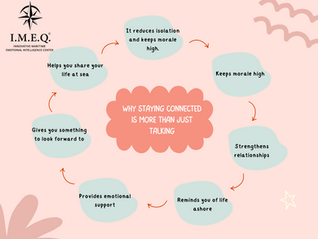Suicide and Depressions
- IMEQ CENTER

- Mar 26, 2018
- 3 min read
Updated: May 31, 2021
FACING THE THREAT OF SUICIDE
You are not alone!
Seafaring is a risky profession! Seafarers are exposed to a number of risk factors , all of which can interact and may lead to serious physical and psychological impairment and most significant suicidal thinking.
“Suicide rates among seafarers have more than tripled since 2014, according to figures from the UK P&I Club. In 2015, suicide was cited as the cause of death in 15.3% of identified mental health cases, having risen from 4.4.% in 2014, according to the Club's internal claims system. “ UK P&I Club.
Between 2001 and 2005, merchant seafarers scored the second highest level of suicides amongst all professions, after coal miners, according to research published by Swansea University in 2013. Many people, especially men, are uncomfortable with the topic of suicide and as a result rarely communicate openly about suicide. Suicide is an important public health issue that is often left hidden in secrecy.
Suicide is associated with several risk and protective factors. There is no single determining cause for suicide, but an interaction of multiple biological, psychological , interpersonal , societal and environmental factors .
Researchers identified some of these risk factors:
History of previous suicide attempts
Family history of suicide
History of depression or other mental illness
History of alcohol or drug abuse
Stressful life event or loss (e.g., job, financial, relationship)
Easy access to lethal methods
History of interpersonal violence
Stigma associated with mental illness and help-seeking
Researchers identified some of the protective factors that buffer individuals from suicidal thoughts.
Skills in problem solving, conflict resolution, and nonviolent ways of handling disputes
Effective clinical care for mental, physical, and substance abuse disorders
Easy access to various clinical interventions and support
Family and community support (connectedness)
Social Network and external support
Cultural or religious beliefs that discourage suicide and support seeking help
Suicide Warning Signs
1.Talking about or making plans for suicide
2. Expressing hopelessness about the future
3. Displaying severe/overwhelming emotional pain or distress
4. Showing worrisome behavioral cues or marked changes in behavior, particularly in the presence of the warning signs above. Specifically, this includes significant withdrawal from or changing in social connections/situations
5.Changes in sleep (increased or decreased)
6.Anger or hostility that seems out of character or out of context
7. Recent increased agitation or irritability
How to Respond :
If you notice any of these warning signs in anyone, you can help!
Ask if they are ok or if they are having thoughts of suicide. Ask the person questions. Find out if the person has a specific plan for suicide. Try to determine what method of suicide the person is considering.
Express your concern about what you are observing in their behavior
Listen attentively and empathically – Maintain eye contact, move close to the person , hold their hand if appropriate
Reflect what they share and let them know they have been heard. Acknowledge the person's feelings. Be understanding, not judgmental or argumentative.
Tell them they are not alone
Remind the person help is available and things will get better. Stress to the person that suicide is a permanent solution to a temporary problem.
Don't promise the person threatening suicide that you will keep this confidential.
Don't try to handle a suicide threat or attempt alone. Involve other people. You don't want to risk your own health and safety.
You need to speak to the officer in charge, a physician or mental health professional or a crisis intervention team in order to protect the person from injury.
Don't leave a suicidal person alone until you are sure they are in the hands of competent professionals. If you have to leave, make sure another friend or family member can stay with the person until they can receive professional help.
Organizational policies and culture on board can address the problem of by implementing programs and policies to address the problem of suicide, raise awareness of existing resources, promote seek helping, and promote a mutual support organizational culture through trainings and awareness programs to officers who can act as agents of change onboard.
SUICIDE HELPLINES





































































































Comments